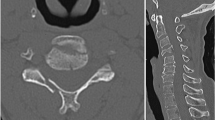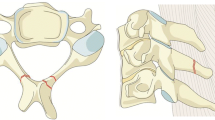Abstract
Cervical spinal trauma occurs with high frequency. Despite its high frequency, the treatment of cervical trauma remains controversial. A primary determinant of surgical decision making is the degree of spinal instability present after the injury. Because this level of stability is difficult to determine, there are wide variations in the treatment of spine trauma. A number of classification systems have been developed, but none have been highly reliable orgained widespread acceptance. Despite this, a number of critical variables in medical decision making, including injury morphology, discoligamentous integrity, and neurological status, have been identified. The Subaxial Cervical Injury Classification (SLIC) system has been developed to define these critical variables and, through a severity score, provide guidelines for treatment.
Access this chapter
Tax calculation will be finalised at checkout
Purchases are for personal use only
Similar content being viewed by others
References
Aebi M, Zuber K, Marchesi D (1991) Treatment of cervical spine injuries with anterior plating. Indications, techniques, and results. Spine 16(3 suppl):S38–S45
Allen BL Jr, Ferguson RL, Lehmann T (1982) A mechanistic classification of closed, indirect fractures and dislocations of the lower cervical spine. Spine 7(1):1–27
Anderson PA et al (2007) Cervical spine injury severity score. Assessment of reliability. J Bone Joint Surg Am 89(5):1057–1065
Bernhardt M, White AA, Panjabi MM (1999) Biomechanical considerations of spinal stability. In: Herkowitz HN (ed). WB Saunders, Philadelphia, pp 1071–1096
Dvorak MF, Fisher CG, Fehlings MG, Rampersaud YR, Oner FC, Aarabi B, Vaccaro AR (2007) The surgical approach to subaxial cervical spine injuries: an evidence-based algorithm based on the SLIC classification system. Spine 32(23):2620–2629
Glaser JA, Jaworski BA, Cuddy BG, Albert TJ, Hollowell JP, McLain RF, Bozzette S (1998) Variation in surgical opinion regarding management of selected cervical spine injuries. A preliminary study. Spine 23(9):975–982
Goldberg W, Mueller C, Panacek E, Tigges S, Hoffman JR, Mower WR (2001) Distribution and patterns of blunt traumatic cervical spine injury. Ann Emerg Med 38(1):17–21
Hadley MN (2002) Guidelines for management of acute cervical injuries. Neurosurgery 50(3):S1–S6
Harris JH, Edeiken-Monroe B, Kopansiky DR (1986) A practical classification of acute cervical spine injuries. Orthop Clin North Am 1(15):15–30
Holdsworth F (1970) Fractures, dislocations, and fracture-dislocations of the spine. J Bone Joint Surg 52(8):1534–1551
Louis R (1985) Spinal stability as defined by the three-column concept. Anatomia Clinica 7(1):33–42
Lowery DW, Wald MM, Browne BJ, Tigges S, Hoffman JR, Mower WR (2001) Epidemiology of cervical spine injury victims. Ann Emerg Med 38(1):12–16
Moore TA, Vaccaro AR, Anderson PA (2006) Classification of lower cervical spine injuries. Spine 31(11 suppl):S37–S43; discussion S61
Patel AA et al (2007) The adoption of a new classification system: time-dependent variation in interobserver reliability of the thoracolumbar injury severity score classification system. Spine 32(3):E105–E110
Vaccaro AR et al (2007) The subaxial cervical spine injury classification system: a novel approach to recognize the importance of morphology, neurology, and integrity of the disco-ligamentous complex. Spine 32(21):2365–2374
Vaccaro AR et al (2005) A new classification of thoracolumbar injuries: the importance of injury morphology, the integrity of the posterior ligamentous complex, and neurologic status. Spine 30(20):2325–2333
White AA, Panjabi MM (1990) (eds) Physical properties and functional biomechanics of the spine. In: Clinical biomechanics of the spine. Lippincott Willam and Wilkins, Philadelphia, pp 22
Wood KB, Khanna G, Vaccaro AR, Arnold PM, Harris MB, Mehbod AA (2005) Assessment of two thoracolumbar fracture classification systems as used by multiple surgeons. J Bone Joint Surg 87-A(7):1423–1429
Woodring JH, Lee C (1993) Limitations of cervical radiography in the evaluation of acute cervical trauma. J Trauma 34(1):32–39
Author information
Authors and Affiliations
Corresponding author
Editor information
Editors and Affiliations
Rights and permissions
Copyright information
© 2010 Springer Berlin Heidelberg
About this chapter
Cite this chapter
Patel, A.A. (2010). Cervical Spinal Stability and Decision Making. In: Patel, V., Burger, E., Brown, C. (eds) Spine Trauma. Springer, Berlin, Heidelberg. https://doi.org/10.1007/978-3-642-03694-1_1
Download citation
DOI: https://doi.org/10.1007/978-3-642-03694-1_1
Published:
Publisher Name: Springer, Berlin, Heidelberg
Print ISBN: 978-3-642-03693-4
Online ISBN: 978-3-642-03694-1
eBook Packages: MedicineMedicine (R0)




